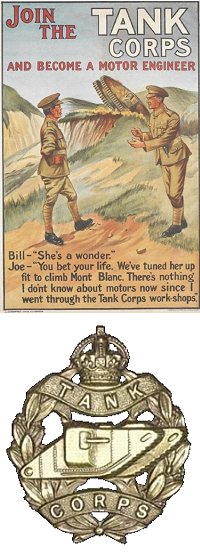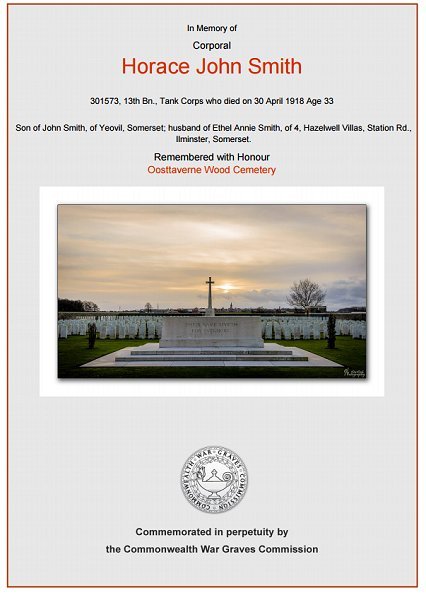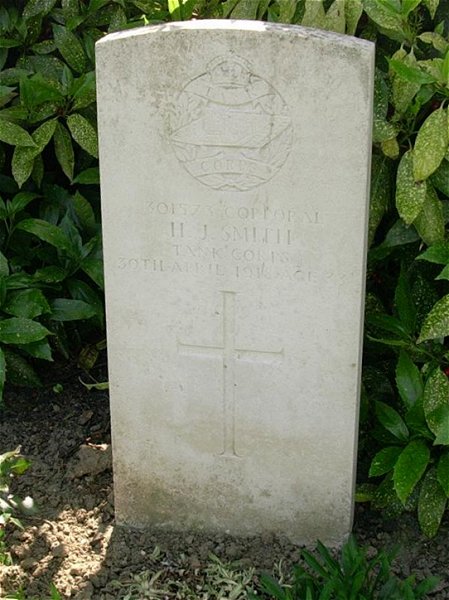yeovil at War
Horace John Smith
Died from his wounds in Germany
Horace John Smith was born in Yeovil in 1886, the son of mason and bricklayer John Smith (1850-1906) originally from Broadwindsor, and Mary Ann née Masters (1853-1893). John and Mary were to have nine children; Herbert (b1876, Martock), Fred (b1877, Dorchester), Edith Mary (b1878, Dorchester), Ada (b1879, Martock), Arthur (b1883, Yeovil), Horace, Amy (b1887, Yeovil), William (b1890, Woolston) and Mary May (1891, North Cadbury -1948). From the birth places of the children it is obvious that the family was somewhat peripatetic, perhaps as John sought employment.
The 1891 census saw the family at North Cadbury and the 1901 census saw them at Bemerton, Wiltshire, at which time 16-year old Horace was a bricklayer like his father. In the summer of 1909 Horace married Ethel Annie Kenway (b1886, Poole, Dorset) at West Ham, Essex. They set up home at 11 Hill View, Sidmouth, Devon where their daughter Doris Ethel was born in 1910.
 Horace
enlisted at
Chard although
it is not known
when. He
initially joined
7th Hussars with
the Service
Number 27618 but
was transferred
to the 13th
Battalion, Tank
Corps where his
Service Number
was 301573. Both
his Service
Numbers suggest
Horace did not
enlist until
1917.
Horace
enlisted at
Chard although
it is not known
when. He
initially joined
7th Hussars with
the Service
Number 27618 but
was transferred
to the 13th
Battalion, Tank
Corps where his
Service Number
was 301573. Both
his Service
Numbers suggest
Horace did not
enlist until
1917.
Originally formed as Companies of the Heavy Section MGC, designated A, B, C and D, each Company consisted of 4 Sections of 3 tanks of each type (male and female Mk 1’s). Companies also had another machine in reserve. In November 1916 the Companies were expanded to Battalions, carrying the same letter designations.
A Battalion consisted of 3 Companies. Three mobile workshops provided the Engineering back-up to service the tanks. An expansion programme was ordered by GHQ, to build a force of 14 additional Battalions. The Tank Corps was formed from the Heavy Branch MGC on 27 July 1917 and the Battalions adopted numbering rather than letter designations (although tank names followed the same lettering: for example, 7th Battalion tanks were all named with a letter G, like Grouse, Grumble, etc.) Each Tank Battalion had a complement of 32 officers and 374 men. It seems likely that Horace joined the 13th Battalion, Tank Corps on its formation.
By summer 1917 tank numbers had increased and the better Mark IV’s were available. Sadly, the tanks deployment in the Third Battle of Ypres (July-November 1917) proved to be another slog through deep mud. The area became a tank graveyard as machine after machine ditched in deep trenches and shell holes, sank, stuck and was shelled. Morale in the Tank Corps was low and confidence of the rest of the army destroyed. Although there was a bright incident when tanks did well at St Julien, the tanks needed to be given a fighting chance.
On 20 November 1917, Byng’s Third Army launched a limited and tactically radical attack at Cambrai, where ground conditions were far more favourable than any seen to date. Following a surprise, hurricane artillery bombardment 378 Mark IV tanks smashed through the Hindenburg Line positions, temporarily creating a rupture to the German lines and the chance for a breakthrough. Insufficient mobile reserves could get through in time to exploit the tanks success, and within days the chance had gone. However, Cambrai proved to be a key learning experience for the British command.
When the German army attacked in March 1918, British tanks were little used as a defensive weapon, but played an important part in the extraordinary counter-attack at Villers-Bretonneux on 24-25 April. During this action they faced for the first time the few German tanks that were ever produced. (The Germans also used captured British tanks, mostly from from Cambrai).
By April 1918 Horace had achieved the rank of Corporal but was seriously wounded in action. According to the Army Register of Soldier's Effects, Horace died in a dressing station in Germany on 30 April 1918 (although he was buried in Belgium close to the French border). He was 33 years old.
Horace Smith was buried at the Oosttaverne Wood Cemetery, Heuvelland, Belgium, Grave I.V.5. His name was added to the War Memorial in the Borough in 2018.
gallery

The Commonwealth War Graves Commission certificate in memory of Horace Smith.

Horace Smith's Commonwealth War Graves Commission headstone at Oosttaverne Wood Cemetery, West-Vlaanderen, Belgium.